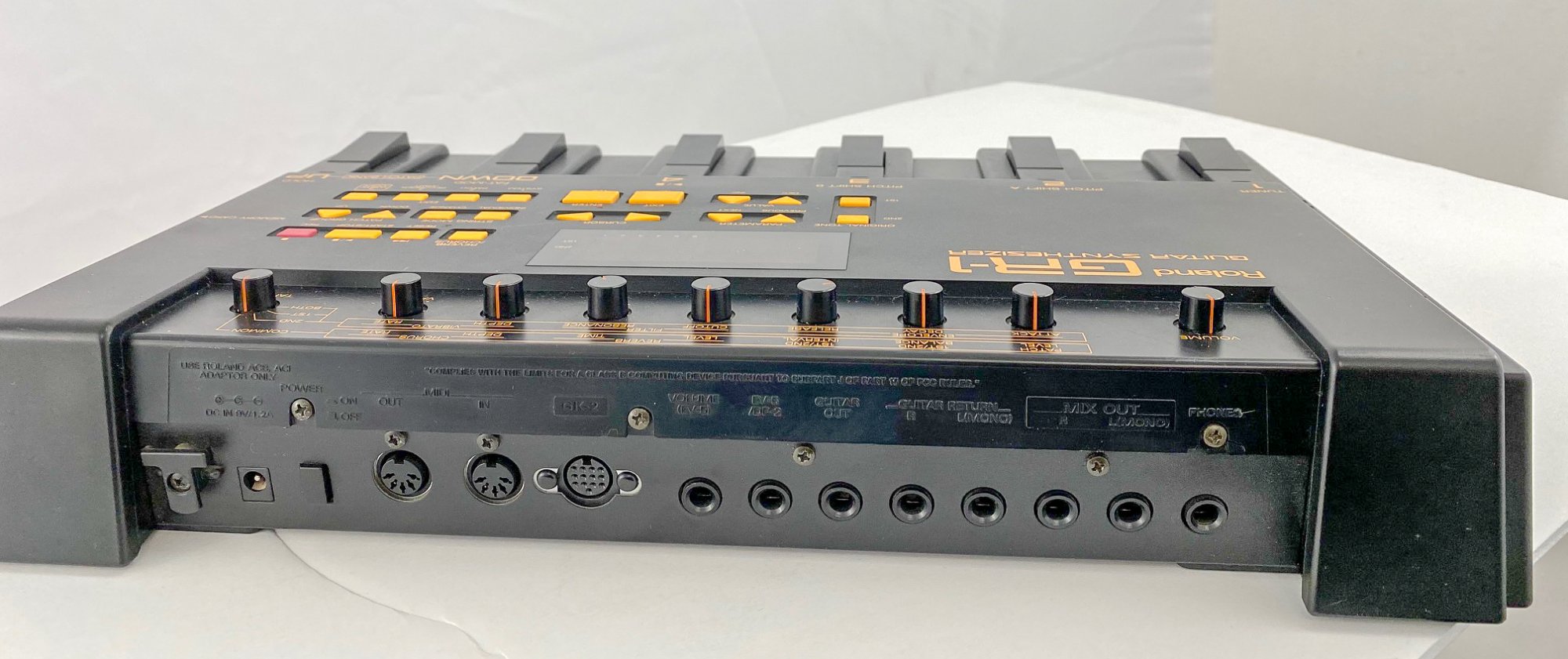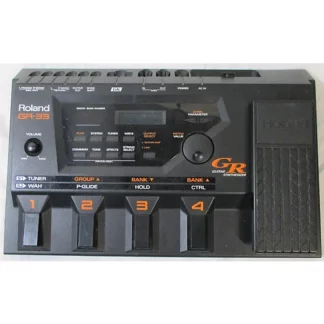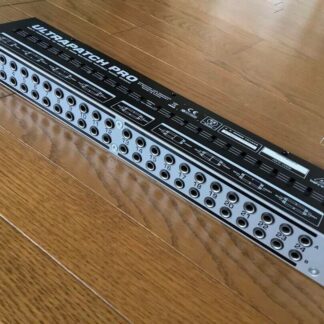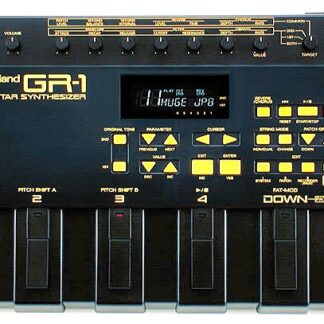Description
Guitar synthesizers have a reputation for being unfriendly, unreliable, and unpredictable. Roland’s GR1 is jam-packed with technical innovations – but will that be enough to satisfy the discerning guitarist? Paul White finds out whether this is really the holy grail (or just a thinly-disguised coffee mug).

Guitar synthesis, for some musicians, has become the modern alchemist’s dream — though instead of attempting to turn base metal into gold, they want to turn heavy metal into MIDI. The keyboard is a supremely efficient way of controlling a synthesizer, because there’s no ambiguity regarding which key is pressed, when it is pressed and when it is released. The guitar, on the other hand, is possibly the most uncooperative instrument on the planet when it comes to controlling synthesizers. With the guitar, notes don’t just go on and off, but start when a string is plucked and then die away slowly until they are no longer audible — it’s relatively easy to find out when a note starts, but the end has to be decided using a threshold system which switches somewhere during the decay of the note. Furthermore, there are no convenient switches on a guitar neck to tell the synthesizer what notes are being played, which is why most contemporary guitar synthesis systems rely on sophisticated circuitry which analyses the pitch of the vibrating string. This is known as pitch tracking and is the system Roland have pursued since their original GR500 model back in the 70s.
Pitch tracking has the advantage that string bends can be followed, giving the player more control over the way in which the synthesizer plays — unfortunately, finding the pitch of a guitar note is no easy task, as the fundamental pitch is mixed in with a series of complex, shifting harmonics. Furthermore, it takes a finite time to analyse the frequency of a vibrating guitar string, which means that there will always be a slight delay between plucking the string and the synth note being sounded. To make matters even more complicated, it isn’t always easy to differentiate between a deliberate hammer-off and a finger being lifted from a sounding string ready to play a new note, and if the system is too sensitive, even the simple action of fretting the strings will cause notes to trigger. Because of these technical hurdles, guitar synthesizers have always been plagued by a frustrating degree of unpredictability.
Enter The GR1
Having thrown what appears to be a metaphorical bucket of cold water over the entire concept of guitar synthesis, I have to confess that I am awed by the way in which the Roland design engineers have tackled, and very largely conquered, the above problems when producing the GR1. Roland’s new guitar synth comes in the form of a floor unit resembling a guitar effects processor and receives its input from the Roland GK2 pickup system. This is a compact, lightweight pickup that fits most standard guitars; provided it is mounted as close to the bridge as possible and around one millimetre away from the fretted strings, the rest of the setting up is handled by software in the GR1. The GK2 actually contains six separate pickups, one for each string — necessary to extract the string pitches when several notes are playing at once — and terminates in a small plastic case containing a couple of buttons, a three-way switch, and sockets for a multicore lead and for the regular guitar output. This box may be screwed to the guitar or fixed with sticky pads — Roland supply a whole bag of sticky pads and spacers, allowing the user to mount the pickup and box in the optimum position with the minimum of fuss. The three-way switch on the GK2 allows the user to flip between guitar, guitar plus synth, and synth only, while the other buttons are used mainly, but not exclusively, to flip the floor pedals from their patch selection mode to their performance control mode.
The System
The GR1 is much more than a box that turns guitar playing into MIDI information — it is closer to the guitar equivalent of a keyboard workstation, in that it contains a multitimbral synth section, a couple of basic but useful effects and a simple sequencer. The synthesizer department includes one section dedicated to the guitar; each string controls its own synth voice, making it possible to bend strings individually in the way that guitarists do and keyboard players generally don’t. This outputs MIDI on six MIDI channels, one for each string, for use with external synthesizers or sequencers, but it can also output on one channel in standard Poly mode where preferred.
The hierarchy of the unit is such that the more sophisticated guitar synth section is permanently assigned to the guitar for live performance (though it can be controlled externally from another MIDI source) while the four-track sequencer has access to its own multitimbral sound source, which provides four musical parts, including one track of drums/percussion. Again, these sources may be controlled from an external sequencer if required or, conversely, the sequence may be output as MIDI data, allowing external sound sources to be used. Local Off switching is provided to facilitate this, and there’s even a way of switching Local Off to on during live performance, by way of an optional footswitch.
The guitar synth sounds as though it’s based on the Sound Canvas range of voices, though I’m told the technology is more closely related to that used in the U20, and each voice patch may use up to two basic Tones, which may then be mixed and modified in a limited but useful way. Each of the 200 basic Tones included is a complete sound in its own right, and most sound like emulations of real instruments, ranging from acoustic piano and string section to slap basses, bells and vibes. ‘Non-real’ Tones are also included, such as Roland’s now-famous ‘Fantasy’ pad sound and a few other overtly synthetic sounds, but the number of gratuitous special effects is mercifully small. These same Tones form the basis of the sounds used in the multitimbral section associated with the sequencer, the difference being that these are not editable and only one Tone may be used within each sound patch. The overall quality of the sounds is excellent, though the on-board effects seem to contribute some background noise.
Effects available include chorus and reverb, and though these aren’t as versatile as those found in dedicated multi-effects units, they produce a convincing sound and are adequately flexible. Between them, the reverb and chorus effects sections can produce treatments ranging from reverb and slap-back delay to flanging and chorus.

Front panel of the GR1.
On The Floor
The GR1 floor unit itself is both compact and uncluttered, with six pedals along the front edge, the display and pushbutton controls in the centre, and a row of real knobs along the back edge. All the signal and MIDI connectors are safely out of harm’s way on the rear panel. In Play mode, the pedals are used to select voice patches; 64 are available, with the option of adding a further 64 by means of a memory card which slots into the side of the unit. All the memory locations come complete with sounds, many of which are excellent, but all may be modified or overwritten by the user — there are no ‘fixed’ factory sounds.
The patches are arranged into two Groups (four if an expander memory card is used), and the desired Group is accessed using a front-panel button, not a pedal. A group is further subdivided into eight Banks, accessible via the right-hand Down/Up pedals, and each Bank contains four patches directly accessible via the remaining four numbered pedals. The patch doesn’t normally change until the final numbered pedal is pressed, even if you swap Banks, but this can be changed to give instant patch changes if that better suits your way of working.
Indeed, the software allows many aspects of the machine to be customised, including the way in which the Hold and Pitch Glide pedals work.
Using the buttons on the GK2, the pedals can be switched out of Play mode, which enables their secondary functions as performance controls. In this mode, pedal 1 accesses the built-in guitar tuner, while pedals 2 and 3 can be programmed to create pitch-sliding effects; you simply select the rate of up/down glide and the final amount of pitch shift. Pedal 4 starts and stops the on-board sequencer, pedal 5 fattens the sound by adding a sub-octave, and the final pedal works as a hold pedal; as set at the factory, this is non-latching and holds all notes played until a new note is played on the same string — in which case the new note replaces the old and continues to hold. A neat patch for Bach experimentation!
Most of the editing is performed via push buttons, and follows the conventional format of nested menus, increment-decrement buttons and Enter/Exit keys. The display is an alpha-numeric plasma type, which makes it easy to read, and this shows Group, Bank and Patch selections, patch titles during performance, and parameter data when editing.
The row of knobs at the top of the machine relate to the main synthesizer section and allow certain parameters to be changed in real time. These changes may be stored as part of a patch and relate to envelope attack, decay and release times, filter resonance and cutoff, and vibrato rate. The filter follows the envelope set up using the attack, decay and release controls. There is also a control for overall volume. A rotary selector switch is used to apply the rotary controls either to Tone 1, Tone 2, or both of the Tones which make up a voice patch. A further switch position gives the knobs a second function relating to common parameters, in which case they control: the patch level; the balance between the two tones; detuning of the tones; reverb level and decay time; and chorus depth and rate. These variables enable the user to make some pretty major changes to the sound in a matter of seconds, even though the available parameters seem to be quite limited. Particularly powerful is the ability to give two Tones different vibrato rates and depth settings which, when combined with the overall chorus, can produce some very rich sounds.
Each patch also has its own overall sensitivity setting and the facility to turn Chromatic on or off. This latter is important, as it disables the pitch bend, making pianos, organs and similar fixed-pitch instruments more convincing.
Hiding away on the rear panel are the power adaptor input and on switch, MIDI In and Out sockets, and the locking multipin plug which accepts the lead from the GK2 pickup. Sockets are provided for external pedals, allowing realtime control, including level and tone balance, while a separate guitar output jack is also provided, allowing the guitar signal to be routed down the multicore to avoid using two leads. This also means that the guitar may be turned on and off from the GK2. The next pair of jacks function as a stereo effects return, which can be useful when using an effects processor on the guitar output of the unit, while the remaining jacks furnish a main stereo output and a phones output.

Diagram from the GR1 ‘s manual, illustrating the unit’s internal layout.
Patches
As touched upon earlier, the sequencer can only make use of the basic Tones with reverb and chorus either selected or not (level and pan can be set), but the main guitar synthesis section is rather more flexible. It can use either one or two Tones and these may be modified using the knobs at the top of the front panel to change the reverb, chorus, envelope and filter characteristics, as well as their relative balance and tuning. To create the guitar equivalent of a keyboard split, Tones may be turned on or off for individual strings — so you could, for example, have a bass sound on the bottom two or three strings and a lead or pad sound on the rest. It is also possible to emulate open guitar tunings by applying different amounts of note shift to each string. This opens up all kinds of interesting possibilities, including bottleneck marimbas! Velocity switching is possible to create, for example, slap bass sounds when you pick harder. The manual also implies that the playing dynamics can be changed for each patch, but in practice, dynamics seems to be either normal or off, with no in-between settings.
“This is the first time I can honestly say that I’ve been able to play a pitch-tracking guitar synth without being conscious of a delay.”
The whole caboodle is 24-Tone polyphonic, so if you’re using the sequencer and a two-Tone guitar patch, all playing six-string chords, that will use up all the available notes. Using the Fat pedal to add sub-octaves also detracts from the overall polyphony. Each musical part can be set to reserve a minimum number of notes so that ‘note stealing’ is less likely to be noticed during complicated musical parts. This is generally more satisfactory than allowing the oldest note played to be ‘stolen’ by the newest one, regardless of its musical importance. When changing parts during performance, any voices still playing the old patch continue to do so, which results in a smooth transition. However, if the two patches are programmed at a different level, the old patch sounds may jump up or down in level as you hit the patch switch. This means you need to be very careful in choosing exactly when to switch patches.
The drum sounds are pretty standard drum kit and percussion stuff, but they are nevertheless very convincing. These can be played from the guitar — not the most intuitive way to program drums — or drum parts can be programmed into the sequencer in step time, using front panel buttons. This latter option records the drum parts with no dynamics, as the pads are not velocity sensitive.
Despite the apparently rudimentary degree of sound programming, by combining two Tones and then varying such parameters as are available, it is possible to create a huge range of quite different sounds. More importantly, it’s possible to do this almost instantaneously, which means that if you want a slightly slower attack to a sound, you can get it without having to struggle with edit menus.
Sequencer
By keyboard standards, the sequencer is exceedingly basic, but it is still useful for knocking up song ideas at home or for providing intros and fills live. Chorus and reverb may be selected for use with the sequencer sounds, but the settings will be the same as those chosen for the guitar synthesizer section. The rather more sophisticated guitar synthesizer section can still be used to play along over sequenced material but it can’t be recorded — all recording is done using the basic Tones, and the fact that they are on a single MIDI channel means no fancy string-independent pitch bending. It is possible to play the guitar synthesizer from an external sequencer, on the understanding that six simultaneous MIDI channels are required — one for each guitar string.
Sequencer data stays in memory if the unit is switched off, though only one song can be stored at a time. These may be saved onto RAM cards, again one card for one song. The sequencer has a built-in metronome, which must be set to the desired tempo before recording; simple editing functions are available, such as copying, erasing and deleting for individual tracks, though you can’t copy data from one track to another. A looping function means that cycling drum parts can be set up, and quantising can be achieved (during recording) with resolutions selectable from 48 pulses per 4/4 bar to two pulses per bar.
Playability
With keyboard synths, the emphasis is mainly on sound and facilities; with guitar synths, playability is by far the most important consideration. With the GR1, once you’ve gone though the setup procedure and set the string sensitivity, as outlined in the manual, the device is incredibly well behaved, considering the near impossible task it has been set. Tracking speed is, to all intents and purposes, instantaneous and this is the first time I can honestly say that ‘ve been able to play a pitch-tracking guitar synth without being conscious of the delay. Even when used to trigger external MIDI modules, the tracking and triggering delay is quite acceptable. External synth modules should, ideally, be set to Mono mode so that they can dedicate a voice to each string of the guitar controlled on separate, consecutive MIDI channels. This allows hammer-ons and string bends to be interpreted properly. You can use a synth module in Poly mode, but string bends and hammer-ons will be ignored, and occasionally a wrong note may trigger, particularly on the lower strings of the guitar.
Guitar players are always worried that they may have to change their style to use a guitar synth. To some extent this is inevitable, as your style has to change every time you pick a different sound. You can’t play fast rock guitar licks using a slow string patch, and neither can you play lingering chords if you’ve chosen a banjo sound. You have to think in terms of the instrument you’re emulating.
Pad sounds and slow-attack strings can be played more or less with impunity, but a little care is still needed when using very percussive sounds, such as piano. It helps to turn the Chromatic on (pitch bend off) for these sounds, but you still have to play fairly cleanly to avoid accidentally triggering notes when taking your finger off a vibrating string; you usually get away with it, but occasionally, the machine interprets a finger movement as a deliberate hammer off. You also have to take care not to brush adjacent strings as you play, especially if they are vibrating, as you could accidentally strike a low-level harmonic which will be reproduced by the synth. A further problem area is that, if the Chromatic function is turned off, the pitch of notes with long sustain times tends to ‘droop’ a little when the guitar note is ‘stopped’. Manually damping the strings with the right hand seems to cure this, and there is no problem if the guitar notes are allowed to die away naturally — it’s lifting the fingers from vibrating strings that seems to cause the trouble.
Though this might sound limiting, it doesn’t take long to make the small adaptations to your playing style that let you control even the more tricky sounds with a high degree of precision. With a little practice, you can easily create snappy bass parts or flowing fretless lines which sound much more convincing that the same thing played on a keyboard synth. Hammer-offs are followed with uncanny accuracy, and the only time I experienced any sort of triggering problem was when playing fast trills to try to simulate steel drums. Occasionally with this sort of playing notes get missed, as the machine isn’t quite sure when one note starts and the other ends.
Summary
There is far more to this innocuously simple looking device than can be written in a review; the half-inch thick manual bears that out! The MIDI implementation on its own could take a whole review. However, the GR1 is pretty simple to use, and the pitch tracking has been improved to such an extent that virtually any guitarist should be able to use it with the minimum of grief.
When Roland brought out their first guitar synth, the GR500, I bought one. Even back in the ’70s, this cost well over £1000, had no MIDI, and was based around what amounted to an analogue monosynth and a polyphonic fuzz box. The tracking was dubious, the delays intolerable — and I loved it. When the GR300 came out, I bought one of those too and indeed, I still have it. That at least was polyphonic, though it still had no MIDI and produced a very limited range of sounds — but I liked it just the same.
Roland GR1
PROS
- The best pitch-tracking guitar synth yet
- Good choice of on-board sounds
- Practical physical layout
- Generally easy to use
CONS
- Uses a separate mains adaptor
- Sequencer is pretty basic
- Some tidying up of playing technique is still necessary
- Internal synth a trifle noisy
PERFORMANCE8/10
VALUE FOR MONEY8/10
Now, a decade and half (plus God knows how much inflation) later, the GR1 offers not only vastly superior guitar-to-MIDI conversion, but also has a good sounding multitimbral synth, nice drum sounds, useful effects and a simple sequencer, at a somewhat lower cost. And it can be fitted to your own guitar. True, if you shop around you can buy a more sophisticated keyboard synthesizer for less money, but if you don’t feel inclined to take that route and spend the change on piano lessons, then the GR1 could be your ticket to instant gratification. Now the guitar player with a home studio (or on stage) can play using all these wonderful sounds that, until now, have been largely inaccessible to him or her. For my money, the only weak area is the sequencer; it has the advantage of ease of use, but it is a little short on facilities for serious songwriting use, and the fact that you have to store songs on costly RAM cards is a nuisance. But then anyone doing serious sequencing will probably want (or already own) a separate sequencer anyway. For the first time in ages, I can feel a mounting urge to reach for my cheque book, and those who know me well will recognise this for the very positive endorsement it is!
The Roland GR-1 is a guitar synthesizer that was released in 1992 by Roland Corporation. It has the following features:
- 200 PCM tones, expandable to 400
- Digital reverb, delay, chorus, and flanging
- Four-part multitimbral via MIDI
- 2000 note internal sequencer
- GK-2A Divided Pickup that can mount on most steel-string guitars






